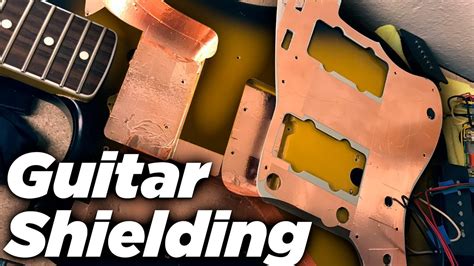How To Shield A Guitar
Ronan Farrow
Apr 02, 2025 · 3 min read

Table of Contents
How to Shield Your Guitar Against Hum and Noise
Are you tired of that annoying hum or buzz ruining your guitar's pristine sound? Guitar shielding is your solution! This comprehensive guide will walk you through the process of effectively shielding your electric guitar, eliminating unwanted noise and improving your playing experience. We'll cover everything from understanding the problem to completing the shielding process, making your guitar sound its absolute best.
Understanding the Problem: Why Does My Guitar Hum?
The annoying hum or buzz you hear in your guitar often stems from electromagnetic interference (EMI). This interference is caused by external sources like power lines, fluorescent lights, and even other electronic devices. Your guitar's pickups, being highly sensitive to electromagnetic fields, pick up this interference, resulting in unwanted noise.
Types of Noise
- 60-cycle hum: This is a low-frequency hum that matches the frequency of alternating current (AC) power lines.
- High-frequency buzz: This is a higher-pitched noise that can vary in intensity depending on the interference source.
- Microphonic feedback: This is a high-pitched squeal caused by vibrations in the pickups themselves. While not directly related to shielding, shielding can sometimes help reduce microphonic feedback.
Preparing for the Shielding Process: What You'll Need
Before you begin, gather the necessary materials. Having everything ready will make the process smoother and more efficient. You will need:
- Conductive copper foil tape: This is the core component for shielding. Ensure you purchase high-quality tape for optimal results.
- Small Phillips head screwdriver: For removing any existing pickguards or control plates.
- Sharp utility knife or scissors: For cutting the copper foil tape to size.
- Grounding wire (optional): For improved grounding, particularly if you're experiencing persistent issues.
- Soldering iron and solder (optional): If you are adding a grounding wire.
- Safety glasses: Protect your eyes from sharp objects and potential solder splashes.
Shielding Your Guitar: A Step-by-Step Guide
This process will vary slightly depending on your guitar's construction, but the general principles remain the same.
1. Accessing the Cavity:
Carefully remove the pickguard (if present) using your screwdriver. This will give you access to the guitar's electronics cavity.
2. Preparing the Cavity:
Clean the inside of the cavity thoroughly using a lint-free cloth. Any dust or debris can interfere with the conductivity of the foil tape.
3. Applying the Copper Foil Tape:
Carefully begin applying the copper foil tape to the inside walls and floor of the cavity. Overlap the edges of the tape by at least half an inch to ensure complete coverage and avoid gaps that can compromise the shielding. Try to avoid wrinkles and creases as much as possible.
4. Grounding the Foil:
This step is crucial. The foil needs to be grounded to your guitar's circuitry to be effective. There are multiple grounding points depending on your guitar’s design. A common location is the back of a potentiometer (volume or tone knob). Use your soldering iron to connect a grounding wire to the foil tape and then to the ground point. If you are unsure about this step, consult a professional.
5. Reassembly:
Carefully replace the pickguard or control plates. Ensure that all screws are securely tightened.
Post-Shielding: Testing and Troubleshooting
After shielding your guitar, test it thoroughly to see if the hum and noise have been significantly reduced. If the problem persists, consider these troubleshooting steps:
- Check your connections: Ensure all connections are secure and that there are no loose wires.
- Examine the foil tape: Look for any gaps or breaks in the foil tape.
- Consider additional grounding: If necessary, add additional grounding points to your circuitry.
- Consult a professional: If you are still experiencing issues, it’s best to consult a qualified guitar technician.
Conclusion: A Quieter, Better-Sounding Guitar
Shielding your guitar is a rewarding project that can significantly improve its sound and playing experience. By following these steps, you can effectively eliminate unwanted noise and enjoy a cleaner, more professional tone. Remember, patience and attention to detail are key to a successful shielding project.
Featured Posts
Also read the following articles
| Article Title | Date |
|---|---|
| How To Spread Ag Lime | Apr 02, 2025 |
| How To Put Ram 1500 In Sport Mode | Apr 02, 2025 |
| How To Sell Lladro Figurines | Apr 02, 2025 |
| How To Show Door Swing In Elevation | Apr 02, 2025 |
| How To Sell Alcohol | Apr 02, 2025 |
Latest Posts
-
Thats Not How You Do It Ch 1
Apr 03, 2025
-
Thats Not How You Do It Chapter 5
Apr 03, 2025
-
Texters How Disappointing Crossword Clue
Apr 03, 2025
-
Taiji Zen Vape How To Unlock
Apr 03, 2025
-
Surge 7 Gram Disposable How To Use
Apr 03, 2025
Thank you for visiting our website which covers about How To Shield A Guitar . We hope the information provided has been useful to you. Feel free to contact us if you have any questions or need further assistance. See you next time and don't miss to bookmark.
